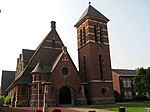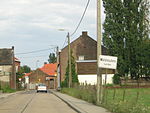Linter, Belgium
Flemish Brabant geography stubsMunicipalities of Flemish Brabant

Linter (Dutch pronunciation: [ˈlɪntər]) is a municipality located in the Belgian province of Flemish Brabant. The municipality comprises the towns of Drieslinter, Melkwezer, Neerhespen (where the canine school of the Belgian police is situated), Neerlinter, Orsmaal-Gussenhoven, Overhespen and Wommersom. On January 1, 2006, Linter had a total population of 7,037. The total area is 36.38 km² which gives a population density of 193 inhabitants per km². The main economic activities of Linter are agricultural and commercial activities.
Excerpt from the Wikipedia article Linter, Belgium (License: CC BY-SA 3.0, Authors, Images).Linter, Belgium
Geldenakenstraat,
Geographical coordinates (GPS) Address Nearby Places Show on map
Geographical coordinates (GPS)
| Latitude | Longitude |
|---|---|
| N 50.8 ° | E 5.05 ° |
Address
Geldenakenstraat
Geldenakenstraat
3350
Flemish Brabant, Belgium
Open on Google Maps









